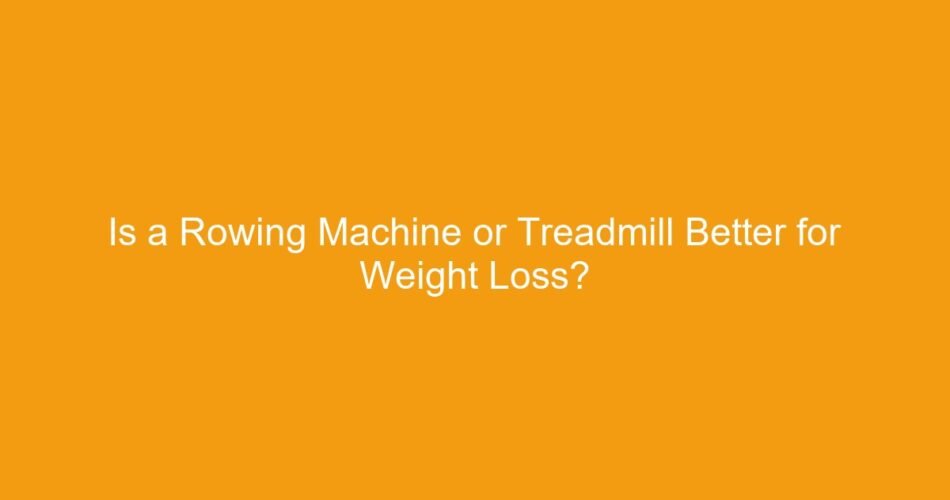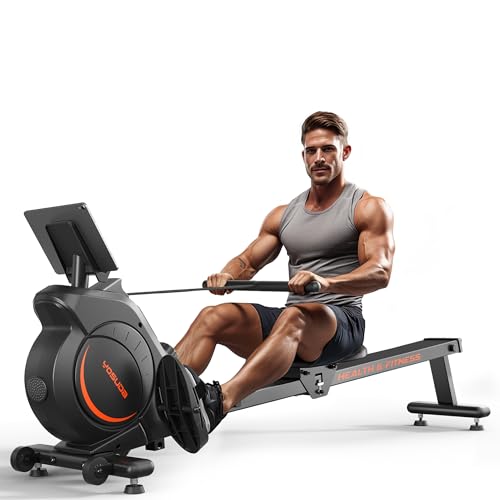The question Is a Rowing Machine or Treadmill Better for Weight Loss? requires evaluating total muscle engagement, calorie expenditure, and long-term sustainability. The answer is nuanced, but the rowing machine offers a superior platform for accelerated weight loss compared to the treadmill because it engages nearly 86% of the body’s muscle groups simultaneously.
For individuals prioritizing maximizing caloric expenditure and increasing lean muscle mass across the entire body, the rowing machine is generally better for weight loss. However, the treadmill remains an outstanding tool for specific cardiovascular health goals and high-impact training, especially for runners. The best machine is always the one you use consistently.
Calorie Burn Comparison and Muscle Engagement
When seeking significant weight loss, the most critical factor is the energy deficit created during the workout. The machine that recruits the most muscle fibers demands the most energy from the body, leading to a higher potential calorie burn.
🛒 Recommended Product
The treadmill primarily utilizes the lower body, targeting the quadriceps, hamstrings, glutes, and calves. While vigorous running is highly efficient, it is overwhelmingly a lower-body exercise.
In contrast, rowing is a compound movement. It divides the work approximately into 60% legs, 20% core stabilization, and 20% upper body (back, shoulders, and arms). Fitness studies consistently show that a rowing session performed with proper form and high intensity can match or even exceed the calorie output of running at a moderate pace, making it highly effective for weight management.
Consider the estimated caloric expenditure for a 30-minute vigorous workout for an individual weighing 185 pounds:
- Vigorous Treadmill Running (6.7 mph): Approximately 444 calories.
- Vigorous Rowing (Ergometer): Approximately 460 calories.
The key distinction is that while the calorie burn is similar at high intensity, the rowing machine achieves this while simultaneously strengthening the core, back, and upper body. This muscle-building aspect contributes significantly to long-term weight loss by increasing the basal metabolic rate (BMR).
The Impact of Exercise Style: Low-Impact vs. High-Impact
Sustainability is crucial for any successful weight loss journey. Many individuals pursuing weight loss are at a higher risk of joint stress, making the impact level of the exercise a vital consideration.
Rowing: The Low-Impact Powerhouse
The rowing machine, or ergometer, is inherently low-impact. The feet are strapped securely, and the motion is a controlled, gliding movement that avoids repeated pounding on joints. This makes rowing an ideal choice for:
- Individuals with pre-existing knee, hip, or ankle issues.
- Those recovering from certain injuries.
- Anyone seeking a powerful full-body workout that can be performed daily without excessive joint wear.
This low-impact nature often allows users to maintain a higher intensity and volume of training over many months, resulting in consistent weight loss progress without mandatory recovery days dedicated to joint rest.
🛒 Recommended Product
Treadmill: High-Impact and Bone Density
Treadmills offer a range of impact levels, from walking (low-impact) to sprinting (high-impact). While high-impact running places significant stress on the joints, this stress is beneficial for building bone density, according to research published by institutions like the American Academy of Orthopaedic Surgeons.
However, high-impact running requires excellent form and specific footwear to mitigate the risk of stress fractures and injuries, especially in the early stages of a weight loss routine. For most beginners, focusing on speed walking or light jogging on the treadmill is the safest approach, but this reduces the overall calorie burn potential compared to vigorous rowing.
Full-Body Conditioning and Afterburn Effect
A major advantage of using the rowing machine for weight loss is its ability to induce a potent afterburn effect, scientifically known as Excess Post-Exercise Oxygen Consumption (EPOC).
EPOC is the amount of oxygen the body consumes after intense exercise to return to its resting state. The greater the muscle damage and the more muscle groups recruited during the workout, the higher the EPOC. Because rowing activates the back, legs, core, and arms simultaneously—using almost all major muscle groups—it places a massive metabolic demand on the body. This means the body continues to burn calories at an elevated rate for several hours after the workout is complete.
While high-intensity interval training (HIIT) on a treadmill can also generate a strong EPOC, the sheer volume of muscle mass mobilized during a proper rowing session often gives it a slight edge in total post-exercise energy expenditure.
Customizing Your Routine: When the Treadmill Wins
While rowing maximizes muscle recruitment, the treadmill is often superior in two specific areas: simplicity and accessibility.
- Ease of Use: Nearly everyone intuitively knows how to walk or run. Mastering the proper rowing technique requires focus on the specific sequence of the “catch, drive, finish, and recovery.” Using incorrect rowing form negates the full-body benefits and increases the risk of lower back strain. A treadmill requires almost no learning curve.
- Specific Heart Rate Training: The treadmill is the definitive tool for training within specific heart rate zones required for marathon training, speed work, or focused cardiovascular endurance, allowing precise control over pace and incline.
For many users, the ease of simply stepping onto a treadmill is enough to ensure they meet their daily cardio goals, which ultimately supports weight loss adherence.
🛒 Recommended Product
| Feature | Rowing Machine (Ergometer) | Treadmill (Running) |
|---|---|---|
| Primary Muscle Focus | Full Body (86% muscle recruitment) | Lower Body (Quads, Glutes, Hamstrings) |
| Potential Calorie Burn | Very High | Very High (Depends on speed/incline) |
| Impact Level | Low-Impact | High-Impact (Running) / Low-Impact (Walking) |
| Joint Health | Excellent, supports long-term consistency | Riskier for joints, better for bone density |
| Primary Goal | Full-body strength and cardiovascular endurance | Focused cardiovascular endurance |
Conclusion
Is a Rowing Machine or Treadmill Better for Weight Loss? While both machines are exceptional tools for cardiovascular exercise and burning calories, the rowing machine offers a more efficient path to weight loss because it is a low-impact, full-body exercise that maximizes muscle recruitment and increases post-exercise calorie burn. For sustainable, whole-body conditioning, the rowing machine is the clear winner for weight loss and overall body composition improvement.
Scientific References & Research
The following peer-reviewed research papers provide additional scientific context:
-
A Temraz (2022).
The effectiveness of using a rowing machine for developing aerobic capacity and technical skills in rowing
[External Link] -
SR Kang et al. (2014).
Comparative analysis of basal physical fitness and muscle function in relation to muscle balance pattern using rowing machines
[External Link] -
H De las Casas et al. (2019).
Eccentric training with a powered rowing machine
[External Link]
Note: External research links are provided for educational purposes and do not necessarily represent endorsement.
Frequently Asked Questions About Is a Rowing Machine or Treadmill Better for Weight Loss?
Q. Is a rowing machine better for overall body composition changes than a treadmill?
A. Yes, a rowing machine tends to be superior for overall body composition changes because it provides a full-body workout, incorporating both significant cardio and resistance training elements that build and tone muscle in the legs, core, and upper body. The treadmill primarily focuses on cardiovascular fitness and lower body endurance, contributing less to upper body muscle development necessary for comprehensive toning. Achieving significant body composition changes often requires building lean muscle, which the rower facilitates more effectively alongside fat loss.
Q. Which machine is better suited for individuals with joint problems or mobility issues looking to lose weight?
A. The rowing machine is generally much better suited for individuals with joint problems because it is a low-impact exercise that minimizes stress on the knees, ankles, and hips while still providing intense cardiovascular training. Running on a treadmill is high-impact, putting substantial force through the lower joints, and although walking is low-impact, it offers a lesser weight- loss stimulus than vigorous rowing. Therefore, the non-weight-bearing nature of rowing makes it the safer long-term option for protecting sensitive joints.
Q. How does the type of exercise—cardio versus strength—affect the long-term weight loss potential of each machine?
A. The treadmill excels purely as a cardiovascular tool, maximizing immediate calorie expenditure, which is crucial for initial weight loss. Conversely, the rowing machine provides a strong blend of cardio and strength training; this muscle-building component increases the user’s resting metabolic rate over time, meaning they burn more calories even when inactive. This metabolic boost makes the rowing machine a powerful tool for maintaining weight loss and preventing regain in the long term.
Q. Can interval training (HIIT) on both machines be equally effective for weight loss?
A. Yes, high-intensity interval training (HIIT) is highly effective on both machines for weight loss, as it maximizes the “afterburn” effect (EPOC) that continues burning calories post-workout. Rowing HIIT targets the entire body for intense bursts, making it metabolically challenging, while treadmill sprint intervals, though lower body dominant, deliver comparable cardiovascular stress necessary for fat oxidation. The key factor is the intensity of the work phases, which should be near maximum effort on either device.
Q. Which machine requires a steeper initial learning curve to use effectively for weight loss?
A. The rowing machine has a significantly steeper initial learning curve because proper technique—the catch, drive, finish, and recovery—is essential to engage the full muscle groups and prevent back strain, requiring careful instruction. In contrast, while advanced running form exists, most people can immediately start walking or jogging on a treadmill with minimal risk and quickly achieve a decent weight-loss workout. Mastering the rowing stroke is necessary to unlock its full calorie-burning potential, whereas treadmill use is immediately intuitive.
Related Articles
What Is the Best Workout Machine for Weight Loss?
Trying to determine what is the best workout machine for weight loss? While several options deliver results, the rowing machine often provides the max…
Do Vibrating Weight Loss Machines Work?
Do vibrating weight loss machines work? The scientific data is clear: while these vibration therapy plates offer proven benefits like muscle stimulati…
Treadmill Workouts for Buttocks: Sculpt and Tone Your Glutes
Getting fit and shaping your buttocks can be challenging. Treadmill workouts might be the solution you need. Treadmill workouts are not just for cardi…
When you purchase a product through Amazon links on EllipticalKing.com, we may earn a small commission at no extra cost to you. This helps support the site and keep our content free.




